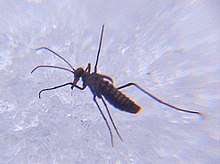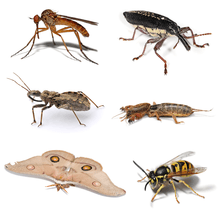Panorpida
Panorpida or Mecopterida is a proposed superorder of Endopterygota. The conjectured monophyly of the Panorpida is historically based on morphological evidence, namely the reduction or loss of the ovipositor and several internal characteristics, including a muscle connecting a pleuron and the first axillary sclerite at the base of the wing, various features of the larval maxilla and labium, and basal fusion of CuP and A1 veins in the hind wings.[1][2] The monophyly of the Panorpida is also supported by recent molecular data.[3]
| Panzygothoraca |
| ||||||||||||||||||||||||||||||||||||
| part of Endopterygota |
| Panorpida | |
|---|---|
 | |
| Celastrina argiolus | |
| Scientific classification | |
| Kingdom: | Animalia |
| Phylum: | Arthropoda |
| Class: | Insecta |
| (unranked): | Endopterygota |
| Superorder: | Panorpida |
| Clades | |
References
| Wikispecies has information related to Panorpida |
- Kristensen, Niels Peder (1975). "The phylogeny of hexapod "orders". A critical review of recent accounts". Journal of Zoological Systematics and Evolutionary Research. 1 (13): 1–44. doi:10.1111/j.1439-0469.1975.tb00226.x.
- Kristensen, Niels Peder (1991). "Phylogeny of extant hexapods". Insects of Australia: 126–140.
- Grimaldi, David; Engel, Michael, S. (2005). Evolution of the Insects. Cambridge University Press. p. 468. ISBN 978-0-521-82149-0.
- Minet, J.; Huang, D-y.; Wu, H.; Nel, A. 2010: Early Mecopterida and the systematic position of the Microptysmatidae (Insecta: Endopterygota). Annales de la Société Entomologique de France (n.s.), 46: 262-270. ISSN 0037-9271




